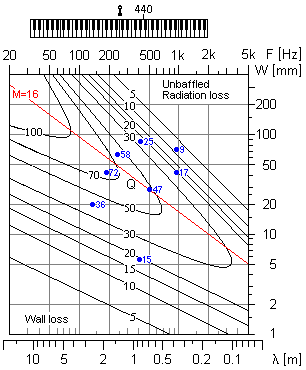Theory
To define a resonator Q value, the archetypal way is to use the oscillating energy stored, divided by the energy lost per radian of the oscillation. There are several equivalent ways, for simplicity more common in engineering. One is to divide the resonator reactance by its series connected loss resistance, the way preferred here, or alternatively a parallel loss resistance divided by the reactance. Elementary concepts relating to Q are outlined by Liljencrants (2002). Equivalent to Q we may use the damping factor d = 1/Q. This is motivated when the damping comes from two or more different mechanisms as in the present case of pipe resonators. We will here derive damping factors for the dominating effects, then add them into a total damping, and finally invert this sum into a resulting total Q value.Here we basically discuss in terms of a quarter wave resonator, closed at one end, of length
The symbol f , though without a subscript, is not used here as a general frequency variable. Instead it universally denotes the fundamental resonance frequency, thus with a firm coupling to resonator length.
Another concept, used in line theory, handles distributed losses in terms of an attenuation constant a = r/2Z + 2Z/g , where Z is the line impedance, r the series and g the shunt resistances per unit length. Because the L - f coupling defines a length this can be rephrased into a damping factor d = c a / (4 f ).
As a first step we settle the resonator reactance, its acoustical mass times angular frequency. With cross section area and radius
where
